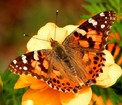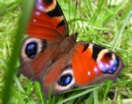

Web design © Graeme de Lande Long. Terms & Conditions.



Community Website
Scaynes Hill Village
There has been an alarming decline in the number of butterflies and moths in the UK. In the last 40 years 75% of butterfly species in the UK have shown a decline, mainly as a result of unprecedented environmental change, habitat destruction on a massive scale, and the use of pesticides and herbicides, especially those containing neonicotinoids. So why does this matter?



Butterflies - can you help?
20 April 2016 Posted by Graeme de Lande Long
Scaynes Hill resident, Arthur McCulloch, a member of the Sussex branch of Butterfly Conservation, has been involved in monitoring and recording butterfly numbers locally for many years. He would very much like to find others in the village who can now take up the baton and so approached the Sustainability Group for their support. So how could you help? Depending on your degree of potential commitment there are three possibilities:-
- Take part in the charity's annual "Big Count", a defined two week period of recording, in July/August (dates for 2016 yet to be announced). Identification sheets can be obtained from the charity and numbers and species identified are then submitted to them within a certain time frame, by post or online.
- Join the "Garden Butterfly Survey" by regularly recording and reporting via a free online account the butterflies that visit your garden over the course of a year.
- Carry out regular surveys in an area outside your garden by monitoring species and numbers of butterflies in the same area or 'transect' ideally on a weekly basis over the whole butterfly season.
Butterflies and moths have been recognised by the Government as indicators of biodiversity, a healthy environment and ecosystems; areas rich in butterflies and moths are also rich in other invertebrates, which collectively provide a wide range of environmental benefits, including pollination and natural pest control. Moths and butterflies are an important element of the food chain and are prey for birds, bats and other insect eating animals. In addition to this butterflies and moths have intrinsic, aesthetic, educational, scientific, health and economic value. Their fragility makes them quick to react to change so their struggle to survive is a serious warning about our environment.

Butterfly Conservation is a charity which aims to study and address these issues and believes that conserving butterflies will improve our whole environment for wildlife and enrich the lives of people now and in the future. Butterfly Conservation runs schemes to record and monitor butterflies, which involve over 15,000 volunteers. These widespread recordings are crucial to their work and the data gathered is used by the Government to indicate the health of the environment at national, UK and European levels.

Painted Lady
Brimstone

Red Admiral

Small Tortoiseshell
Butterflies by their colourful nature are relatively easy to identify, particularly many of the common species. There is a good identification guide on the Butterfly Conservation website and many handy pocket guides available from bookstores or online. However, the Sustainability Group will be organising a practical field session on identification with Arthur McCulloch on Mike Lavelle's wildflower meadow in late Spring/early Summer. This arrangement may need to be fairly impromptu as it will be depend on finding a sunny day, so if you would be interested in taking part in that or any of the surveys please contact Graeme de Lande Long (831364) for more details.

Peacock
Any butterfly survey is best done on a bright, sunny day, when the air temperature has had time to rise, making the butterflies more active.